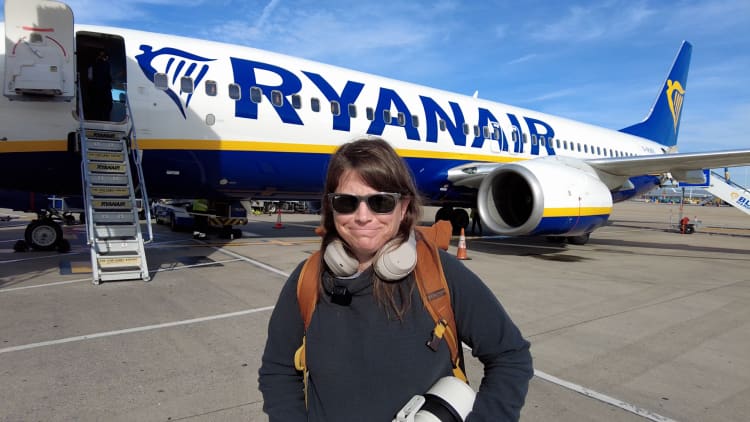Passengers check in at the Spirit Airlines counter at the Fort Lauderdale-Hollywood International Airport on February 07, 2022 in Fort Lauderdale, Florida.
Joe Raedle | Getty Images
Spirit Airlines, an icon of budget air travel that reshaped the industry, has filed for bankruptcy protection after years of mounting losses, a failed merger, increased competition and more demanding consumer tastes.
The carrier early Monday reached a prearranged deal with its bondholders, including $300 million in debtor-in-possession financing, to help it through the bankruptcy, which it said it expects to exit in the first quarter of next year. Spirit said vendors and aircraft lessors will not be impaired. Spirit listed its assets and liabilities between $1 billion and $10 billion, in a court filing.
The airline said it expects to continue operating, and CEO Ted Christie tried to reassure customers that they can still book, fly and use loyalty points on the carrier.
“The most important thing to know is that you can continue to book and fly now and in the future,” Christie said in a letter to customers on Monday.
Spirit is the first major U.S. airline to file for Chapter 11 since American Airlines 13 years ago.
Host of challenges
A Spirit Airlines plane at New York’s LaGuardia Airport
Leslie Josephs/CNBC
The Dania Beach, Florida-based airline had struggled with an engine recall that grounded dozens of its jets, a surge in costs after the pandemic, and the failure of its planned acquisition by JetBlue Airways, which was blocked by a federal judge earlier this year on antitrust grounds. Its shares have fallen more than 90% this year.
The airline had repeatedly pushed back a deadline with its credit card processor to renegotiate $1.1 billion in loyalty bonds due next year or risk losing the ability to process transactions.
It said Monday that it had reached a deal with bondholders for $350 million in equity and that noteholders will swap $795 million for equity. Spirit’s stock will be delisted from the New York Stock Exchange as a result of its filing, in the U.S. Bankruptcy Court of the Southern District of New York.
Last week, Spirit said it had to delay its quarterly filing and said it was in discussions for a deal with a majority of creditors that would not affect customers, vendors, suppliers and others, but that would wipe out the company’s existing equity.
Spirit had said it expects its third-quarter operating margins were 12 percentage points below its negative-15% margin it posted a year ago as costs surged and fares slipped. Sales fell $61 million.

Spirit Airlines and NYSE Arca Airline index
The airline hasn’t had a profit since 2019 and it lost more than $335 million in the first half of the year.
To try to make up the difference, it has sold dozens of jets to shore up cash, which worked in its favor since planes are in short supply this year. Most recently, it sold 23 Airbus aircraft to GA Telesis to generate $519 million. Spirit has said it expects to end the year with approximately $1 billion in liquidity.
The company also plans to furlough another 330 pilots in January on top of about 200 in September as it slashed routes. But analysts expect the carrier will have to shrink further in bankruptcy to get a handle on costs.
The Spirit way
Spirit’s business model of offering rock-bottom fares and fees for everything from seat assignments to cabin baggage was a success with bargain-hunting customers, allowing it to expand over more than a decade.
Its bare-bones service became a favorite punchline for stand-up comics. A greeting card featuring a drawing one of the carrier’s yellow planes even states: “I would fly Spirit Airlines for you.”
The low-fare and add-on-fee model sparked similar offerings from larger carriers like Delta, American and United, which rolled out basic economy fares.
Spirit struggled after the pandemic, however, when costs rose throughout the industry and lifted travel restrictions sparked a surge in bookings for international trips outside of Spirit’s network. Fares fell in the oversupplied U.S. market.
Spirit this summer started offering bundled fares with seat assignments and other perks, as well as a sort of “first-class” that included larger seats at the front of the plane as many travelers have opted to pay up for more spacious seats on board.
In January, a federal judge blocked JetBlue’s $3.8 billion planned acquisition of Spirit. In early 2022, Spirit had a deal to merge with fellow budget airline Frontier before JetBlue swooped in with a bid in April of that year. Spirit shareholders backed JetBlue’s all-cash offer.
Judge William Young, who was appointed by former President Ronald Reagan, said the JetBlue deal would drive up fares and reduce competition. The airlines had argued it would help them better compete, especially in the U.S. where four airlines control about three-quarters of the market.
“Spirit is a small airline. But there are those who love it,” Young wrote in his ruling. “To those dedicated customers of Spirit, this one’s for you.”
Some analysts expect Frontier and Spirit to resume talks in the coming months.

watch now
